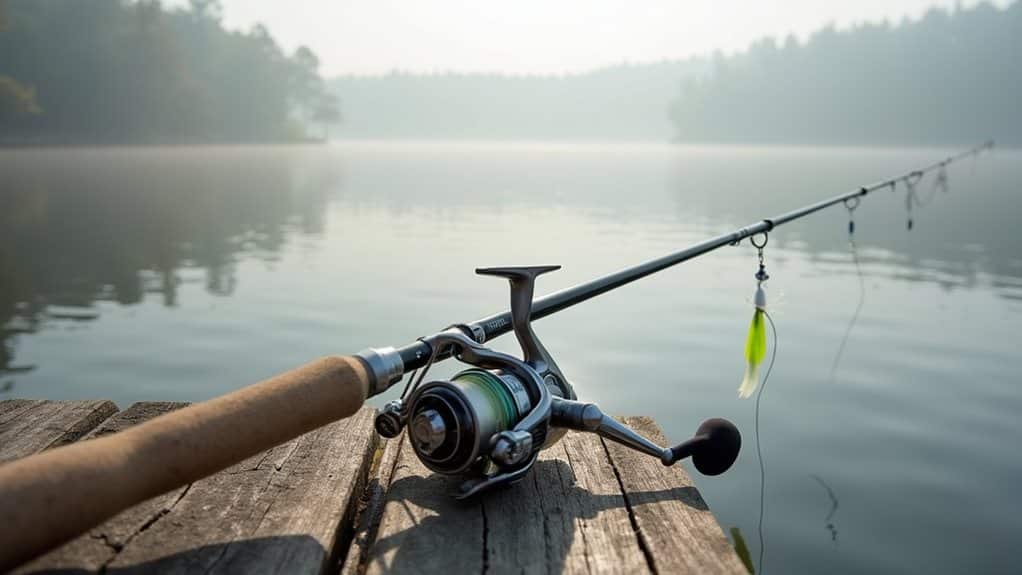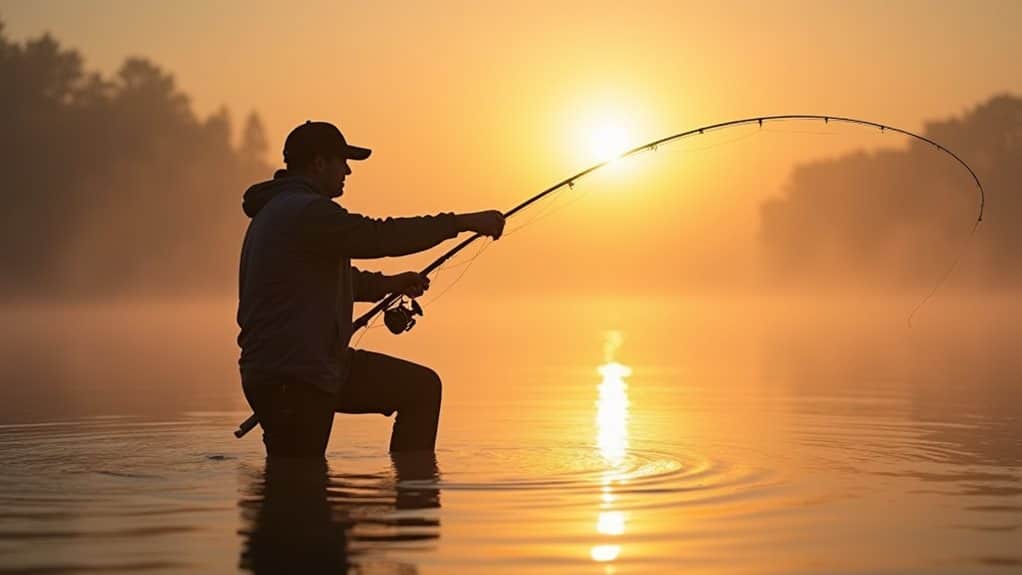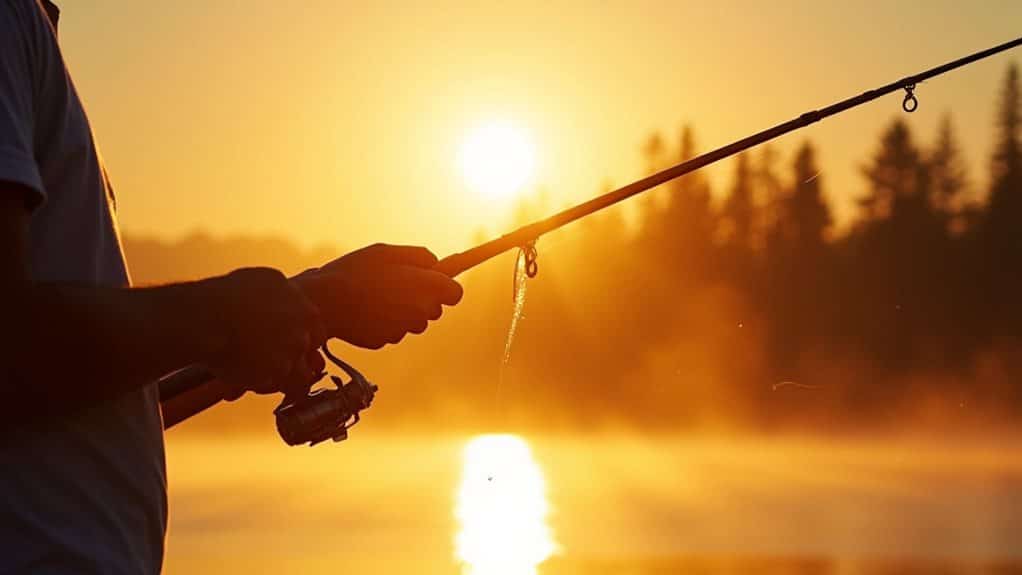To cast a light lure like a pro, you’ll need a fast-action rod between 7’4″ and 9’6″ paired with a high-speed reel in the 3000-4000 size range. Position your feet shoulder-width apart, keeping the lure 2-3 feet from your rod tip. Focus on smooth, wrist-based motions while engaging your entire body for power. Use braided mainline with a fluorocarbon leader for ideal distance and stealth. Master these fundamentals, and you’ll uncover even more techniques to enhance your casting game.
TLDR
- Choose a longer rod (7’4″ to 9’6″) with fast action and pair it with a high-speed reel for optimal control.
- Position your feet shoulder-width apart and keep the lure 2-3 feet from the rod tip before casting.
- Use a smooth, wrist-based casting motion while engaging your entire body to leverage the rod’s natural flex.
- Match braided mainline with fluorocarbon leader to achieve better casting distance while maintaining stealth.
- Maintain proper reel tension and magnetic brake settings to prevent backlash during light lure casting.
Essential Equipment for Light Lure Casting

Three essential components form the foundation of successful light lure casting: your rod, reel, and line setup.
You’ll want a longer rod, typically 7’4″ to 9’6″, with fast action for ideal advantage and control. The St. Croix Legend Xtreme is an excellent rod choice for optimal casting performance. Fishing can also provide stress relief through the repetitive activity involved in casting and reeling.
Pair it with a high-speed reel in the 3000-4000 size range, and choose a braided mainline with a fluorocarbon leader for maximum casting distance and stealth.
Mastering the Basic Casting Motion
Dominating the basic casting motion starts with proper body positioning and rod control.
Stand with your feet shoulder-width apart and position your lure 2-3 feet from the rod tip. You’ll want to engage your entire body, including legs and back, while maintaining proper wrist technique for control. Smooth casting motions will help you achieve greater distances by taking advantage of your rod’s natural curve. Additionally, understanding sonar technology can enhance your fishing experience by locating fish more effectively.
Remember to use the rod’s full flex to generate power, and time your release carefully to prevent backlash.
Advanced Techniques for Distance and Accuracy

Building on your basic casting foundation, you’ll need to engage your entire body, from your legs through your core to your arms, to generate the power needed for launching light lures to distant targets.
When facing challenging weather conditions, especially wind, you’ll want to adapt your casting angle and path to maintain accuracy while still achieving distance.
Your success with light lures often depends on selecting the right cast for your specific target, whether that’s a roll cast for getting under overhanging branches or a sidearm cast for windy conditions. Additionally, knowing the best fish to catch can help you tailor your techniques to target specific species effectively.
Body Mechanics for Power
Mastering body mechanics stands as the cornerstone of achieving greater power and distance when casting light lures.
To maximize your cast, you’ll want to engage your entire body, starting from your legs and moving through your torso.
Don’t rely solely on your arm – instead, coordinate a fluid motion where you’ll flick your wrist at the release point while maintaining proper timing through your backswing.
Wind and Weather Adaptation
When fishing in challenging weather conditions, adapting your casting technique becomes essential for maintaining both distance and accuracy with light lures.
Use a sidearm or roll cast to keep your lure close to the water’s surface, and opt for braided line with zero memory to reduce wind resistance.
Consider switching to a fast-action rod and slightly heavier lures for better control and stability.
Target-Specific Cast Selection
Successful light-lure fishing depends heavily on selecting the right cast for your specific target and situation.
For open water, you’ll want to use forehand casting to maximize distance, while backhand techniques work better in areas with dense cover.
When precision is essential, try lateral casting to reduce wind interference, and don’t forget to adjust your casting angle based on surrounding obstacles and target location.
Selecting the Perfect Rod and Reel Combo

When you’re choosing a rod and reel combo for light lures, you’ll want to match your rod’s action and length to create the perfect balance for casting accuracy and distance.
For ideal performance, start with a medium-light action rod between 7-8 feet, paired with a 2000-2500 size spinning reel that has a gear ratio of 6.0:1 to 6.4:1.
Your combo’s overall weight distribution should feel balanced in your hands, with the reel’s weight complementing the rod’s action to help you detect subtle bites and maintain control throughout your cast. Additionally, selecting the right hook type, such as circle hooks, can significantly improve your catch-and-release success.
Matching Action With Length
Selecting the perfect rod and reel combo requires careful consideration of both action and length, as these two factors work together to determine your casting success.
You’ll want to pair a fast-action rod with shorter lengths for precise casts in tight spaces, while longer rods with medium action provide better distance casting.
Essential Gear Ratio Settings
Beyond choosing the right rod action and length, mastering gear ratios will take your light lure casting to the next level.
For light lures, you’ll want to select a higher gear ratio reel, typically in the 7.1:1 to 9.0:1 range.
These faster ratios help you maintain better line control and allow for quick retrieval, which is essential when you’re working with lightweight presentations in varying conditions.
Weather and Environmental Considerations
Understanding weather and environmental conditions plays an essential role in successful light lure casting.
When you’re casting with the wind at your back, you’ll achieve better distance, while headwinds require more force and a lower path.
Choose brighter lures for clear water and darker ones for better underwater contrast.
During warm fronts, you’ll find fish are more active, making faster presentations more effective.
Common Casting Mistakes to Avoid

When casting light lures, even small mistakes can greatly impact your fishing success.
Don’t force your cast with too much arm or shoulder power; instead, rely on a smooth, wrist-based motion.
You’ll also want to guarantee your rod and lure weights match properly, and keep your reel’s tension and magnetic brake settings properly adjusted.
Remember to practice regularly and adapt your technique for different conditions.
Tips for Casting in Tight Spaces
Successfully casting in tight spaces requires commanding specific techniques that’ll help you steer around obstacles while maintaining accuracy.
For the best results, try the dart cast method when you’ve got overhead clearance, or switch to sidearm casting when trees block your path.
When space is extremely limited, you can’t go wrong with the flipping technique for precise lure placement.
Fine-Tuning Your Gear for Better Performance

Beyond mastering specific casting techniques, getting the most out of your light lure setup requires careful attention to your gear’s performance capabilities.
You’ll want to focus on upgrading your reel’s bearings, polishing contact points to reduce resistance, and ensuring your line diameter matches your reel specifications.
Don’t forget to check your spool line length, as excess line can actually hinder your casting proficiency.
Final Note
You’re now equipped with the essential skills to cast light lures like a seasoned angler. Remember to practice your technique regularly, maintain your gear properly, and stay patient as you develop your casting precision. Whether you’re fishing in tight spaces or open water, these fundamentals will serve you well. Apply what you’ve learned about equipment selection, casting mechanics, and environmental adaptations, and you’ll soon be casting with confidence and consistency.




